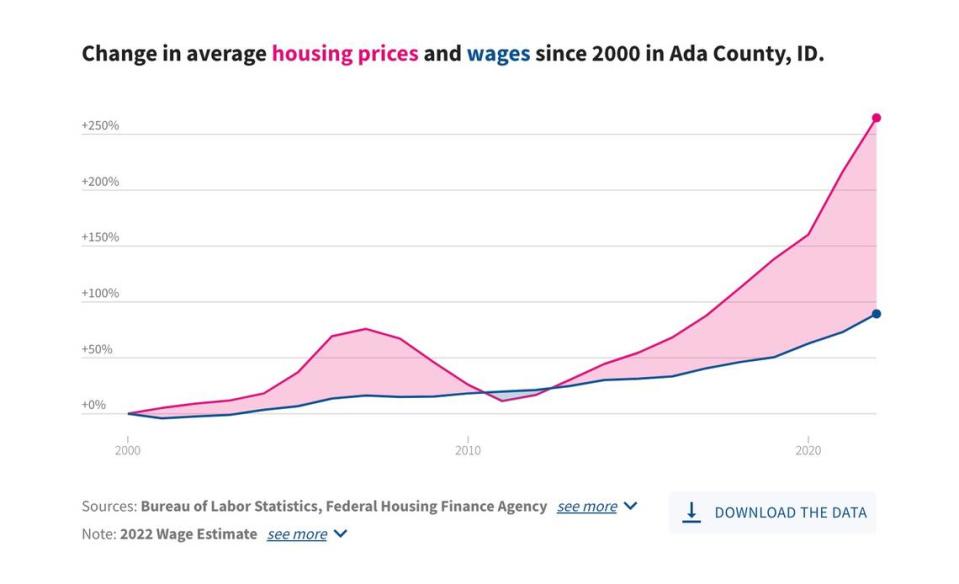As Idaho home prices skyrocketed, wage increases lagged. Here’s how big the gap is
Home prices in Idaho have been outpacing wages for years, but a new report shows just how much the disparity has grown.
Using the latest data from the Bureau of Labor Statistics, Federal Housing Finance Agency, U.S. Census Bureau and Freddie Mac, the nonprofit USAFacts found that in Idaho the median cost of a home increased nearly two and a half times faster than the average pay over the past decade.
Home prices rose 146% from 2010 to 2022, and in that same time period, the average wage rose only 60%.
The average annual wage in the Gem State was $54,000 in 2022; the median home price was $440,000. A mortgage calculator website shows that you’d need to make about $130,000 a year to afford a house of that cost.
USAFacts analyzed median home price values from the American Community Survey, which does not report average prices, according to Amber Thomas, a data visualization engineer for USAFacts. The organization used those numbers in comparison with average wages, rather than median, because the Bureau of Labor Statistics does not provide median wage data.
The gap between the two metrics, home prices and wages, is a symptom of Idaho’s population growth in the past 10 years.
In Ada and Canyon counties, population increased by 220,242 people since 2010, or 38%, to more than 800,000 people, according to new estimates from the Community Planning Associations of Southwest Idaho, or COMPASS.

As the Treasure Valley gained tens of thousands of new residents, demand for housing outstripped supply.
“That drove home prices much higher,” Robert Spendlove, an economist at Zions Bank who studies housing trends, told the Idaho Statesman by phone, noting that “housing demand increased dramatically.”
Spendlove said people from coastal states like California and Washington have migrated to Idaho in recent years because of its purported quality of life. And when Idaho’s recent growth first began, home prices here were comparatively affordable, but that’s changed in the past few years, he said.
In fact, rising housing costs around the state have now landed Idaho on a list of the worst states in the U.S. for first-time homebuyers.
Boise gained notoriety across the country for its explosive growth. The city made national headlines as a so-called “boom town,” alongside metros like Austin, Texas, and Phoenix, because of its overheated real estate market that ramped up near the start of the pandemic in 2020.
Meanwhile, wages paid to Idaho workers have failed to keep up.
In Ada County, home prices rose 129% faster than wages over the past decade, and in Canyon County, they rose 191% faster, according to the report. The further back the data goes, the more the gap widens.
Between 1990 and 2022, home prices in Ada County rose 466% and the average wage rose 204%. In Canyon County, during the same time frame, home prices rose 496% and wages rose 191%. The report from USAFacts includes an interactive map with comparisons for each county in the U.S. where data is available.
During the pandemic, home prices accelerated more quickly than wages in nearly every county in the United States.
And despite home sales cooling down over the past several months, the cost of a single-family home in the Treasure Valley is still far above what it was five years ago. The median price in Boise was $458,615 last March, up from $296,500 in March 2018, according to the real estate agency Redfin.
“In the last year, we’ve seen year-over-year housing prices come down again, but it hasn’t erased the big increases we’ve seen since 2020,” Spendlove said.
He also noted that Idaho’s wage growth over the past decade surpassed that of Utah, Colorado, Arizona and Nevada, all of which were also in the top 10 states for home prices outpacing wages.
Wages increased by 47% in Nevada, 52% in Arizona, 58% in Colorado and 59% in Utah. In Idaho, wages rose 60%.
“Of the intermountain states, Idaho saw the biggest wage increase since 2010,” Spendlove said. “However, the reason there’s that big disparity is because home prices have gone up by so much more.”
How other states fared
Affording a home in Idaho has become more difficult over the past decade, especially when compared with residents’ income, but the Gem State isn’t quite the worst off.
Here are the 10 states with the largest disparities in terms of home prices outpacing wages:
Nevada — Housing prices rose 115% faster than wages
Arizona — 93%
Idaho — 86%
Florida — 82%
Utah — 73%
Colorado — 67%
Texas — 55%
California — 49%
Oregon — 42%
Tennessee — 42%
Spendlove said Idaho’s gap should narrow now that demand for single-family homes has declined as interest rates rise.
“One of the dynamics with wages is that when they go up, they never come back down again — we call that sticky,” he said. “So employers are really reluctant to raise wages if they don’t have to, because they know they can never drop them again.
“But with housing prices, they can fluctuate up and down. As housing prices stabilize, that gap should narrow a little bit as we continue to see positive wage growth in the state.”

